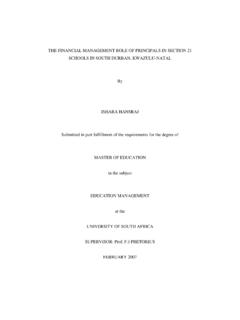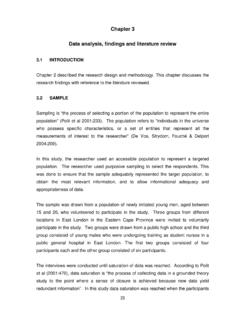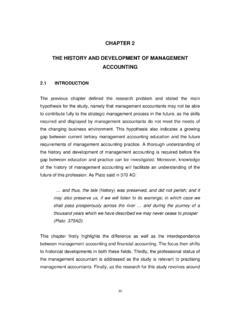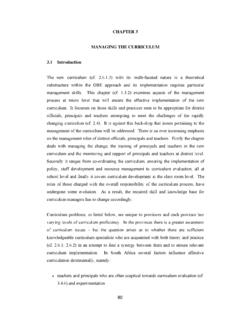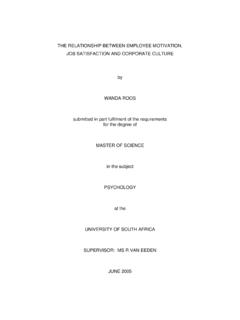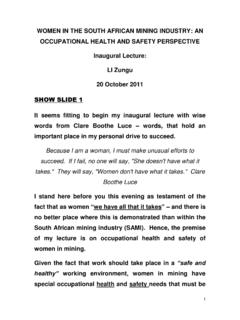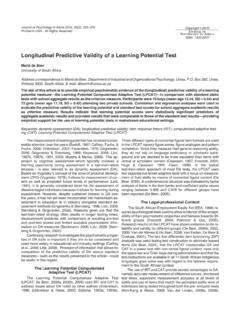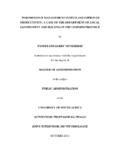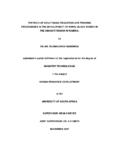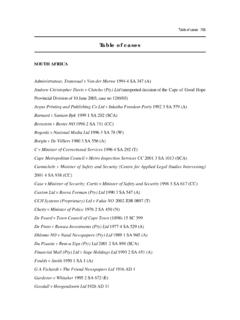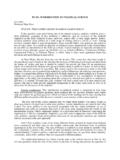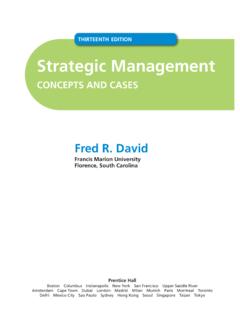Transcription of CHAPTER 2 ORGANISATIONAL CULTURE
1 12 CHAPTER 2 ORGANISATIONAL CULTURE CHAPTER 1 explored the background to and the motivation for this study, with specific reference to ORGANISATIONAL CULTURE and ORGANISATIONAL commitment as the main constructs. In this CHAPTER the concept ORGANISATIONAL CULTURE is explored in more detail. This CHAPTER s main focus areas include the following theoretical aspects of the concept ORGANISATIONAL CULTURE : background, definition, model, dimensions, development, change and management of CULTURE . THEORETICAL BACKGROUND TO THE CONCEPT ORGANISATIONAL CULTURE Social scientists have explored the notion of ORGANISATIONAL CULTURE as a perspective in ORGANISATIONAL theory over the past decades. Brown (1998, p 2) states that current interests in ORGANISATIONAL CULTURE stems from at least four different sources: climate research, national cultures, human resource management and from conviction approaches which emphasise the rational and structural nature of the organisation to be unable to offer a full explanation of ORGANISATIONAL behaviour.
2 Research findings by means of ORGANISATIONAL climate surveys that were conducted in the 1970s suggest that ORGANISATIONAL CULTURE seems to be a sophisticated approach to understand the beliefs and attitudes of individual members about their respective organisations (Brown, 1998). The origin of ORGANISATIONAL CULTURE from a national CULTURE point of view is based, among others, on the work of Deal and Kennedy (1982). According to this view ORGANISATIONAL CULTURE is seen as being central to ORGANISATIONAL success rather than factors such as structure, strategy or politics. As a result the attention shifted away from national cultures and focused more on ORGANISATIONAL CULTURE . 13 Interests in ORGANISATIONAL CULTURE from the human resource management and performance point of views stems from the fact that ORGANISATIONAL CULTURE was perceived to be offering a non-mechanistic, flexible and imaginative approach to understanding how organisations work (Brown, 1998).
3 Consequently, ORGANISATIONAL CULTURE is considered to be the great cure-all for most ORGANISATIONAL problems (Wilson, 1992). Other theoretical development of the concept ORGANISATIONAL CULTURE includes studies conducted within the field of ORGANISATIONAL theory. These studies focused on the description and understanding of the concept organisation CULTURE by using typologies or classifications, which include the following: Deal and Kennedy (1982) identified four generic types of cultures to describe ORGANISATIONAL CULTURE , namely the tough-guy/macho CULTURE , the work-hard/play-hard CULTURE , the bet-your company CULTURE and the process CULTURE . Handy (1985) described ORGANISATIONAL CULTURE by using four types of classification, namely power , role, task and person cultures.
4 Schein (1985) used three levels to explain ORGANISATIONAL CULTURE , namely artefacts, values and basic underlying assumptions. Scholtz (1987) identified five primary CULTURE typologies, namely stable, reactive, anticipating, exploring and creative. Hampden-Turner (1990) used four types of CULTURE to describe ORGANISATIONAL CULTURE , namely role, power , task and atomistic cultures. Hofstede (1991) highlighted that cultures differ based on five dimensions, namely power distance, individualism/collectivism, uncertainty avoidance, masculinity/femininity and confusion dynamism. O Reilly, Chatman and Caldwell (1991) presented seven primary characteristics to describe ORGANISATIONAL CULTURE , namely innovation and risk-taking, attention to detail, outcome orientation, people orientation, team orientation aggressiveness and stability.
5 14 The above-mentioned typologies of ORGANISATIONAL CULTURE provide broad overviews of the variations that exist between theorists in their description of this concept. The variations and differences have mainly evolved over time. 2. 2 DEFINITION OF ORGANISATIONAL CULTURE A basic definition of ORGANISATIONAL CULTURE is necessary to provide a point of departure in the quest for an understanding of the phenomenon. Martins and Martins (2003, p 380) state the general definition of ORGANISATIONAL CULTURE as a system of shared meaning held by members, distinguishing the organisation from other organisations . In relation to the above definition, Arnold (2005, p 625) indicates that ORGANISATIONAL CULTURE is the distinctive norms, beliefs, principles and ways of behaving that combine to give each organisation its distinct character.
6 These two definitions suggest that ORGANISATIONAL CULTURE distinguishes one organisation from another organisation. Therefore, ORGANISATIONAL CULTURE is to an organisation what personality is to an individual (Johnson, 1990). Linking up with the above definitions, Schein (1985, p 9) also defines ORGANISATIONAL CULTURE as a pattern of basic assumptions invented, discovered, or developed by a given group as it learns to cope with its problems of external adaptation and internal integration that has worked well enough to be considered valid, and therefore, to be taught to new members as the correct way to perceive, think, and feel in relation to those problems . This description highlights that ORGANISATIONAL CULTURE is created assumptions, which are accepted as a way of doing things and are passed on to new members of an organisation.
7 For new employees this would mean adaptive behaviour within the organisation that leads to new belief systems. This new and adaptive behaviour instilled through ORGANISATIONAL values and beliefs are associated 15with rituals, myths and symbols to reinforce the core assumptions of ORGANISATIONAL CULTURE (Hofstede, 1991). In relation to the above definition, Brown (1998, p 9) defines ORGANISATIONAL CULTURE as the pattern of beliefs, values and learned ways of coping with experience that have developed during the course of an organisation s history, and which tend to be manifested in its material arrangements and in the behaviours of its members . This suggests that ORGANISATIONAL CULTURE is articulated in the organisation, in order to shape the way in which ORGANISATIONAL members should behave.
8 However, this pattern of values, norms, beliefs, attitudes, principles and assumptions may be unwritten or non-verbalised behaviour that describe the way in which things get done; to give the organisation its unique character (Brown, 1998). Given the various definitions of ORGANISATIONAL CULTURE which were discussed in this section, the adopted and relevant definition for this study is stated by Harrison (1993, p 11) as the distinctive constellation of beliefs, values, work styles, and relationships that distinguish one organisation from another . In other words, ORGANISATIONAL CULTURE includes those qualities of the organisation that give it a particular climate or feel. As a result the distinct qualities of an organisation may manifest through four dimensions, namely power , role, achievement and support (Harrison, 1993).
9 ORGANISATIONAL CULTURE MODEL There are different descriptive models that attempt to diagnose ORGANISATIONAL CULTURE in the field of ORGANISATIONAL development. Harrison (1993) presents a theoretical model for the purpose of diagnosing ORGANISATIONAL CULTURE which is adopted in this study. 16 HIGH FORMALISATIONROLE ACHIEVEMENT LOW CENTRALISATION HIGH CENTRALISATION SUPPORT power LOW FORMALISATION Figure : ORGANISATIONAL CULTURE Model by Harrison (1993) 17 Harrison (1993, p 8) states that though the model is intended to be descriptive rather than evaluative, there is a tendency to perceive it in evaluative terms . This descriptive model creates an awareness of the CULTURE gap between the existing and preferred cultures in an organisation (Harrison, 1993). Furthermore, this model maintains that ORGANISATIONAL CULTURE can be diagnosed in four cultural dimensions, namely power -oriented CULTURE ; role- oriented CULTURE ; achievement-oriented CULTURE ; and support-oriented CULTURE (Harrison, 1993).
10 The ORGANISATIONAL CULTURE model presented in figure indicates that the four dimensions of CULTURE orientation are measured within two modes of operation, which are formalisation and centralisation (Harrison, 1993). Both modes of operation can be measured on a scale of low or high levels. According to Martins and Martins (2003, p 382) high formalisation in an organisation creates predictability, orderliness and consistency . In other words, a strong CULTURE can serve as a substitute for formalisation. This suggests that the organisation s formal rules and regulations which act to regulate its members behaviour can be internalised by ORGANISATIONAL members when they accept the organisation s CULTURE ; this takes place without the need for written documentation (Martins & Martins, 2003).
